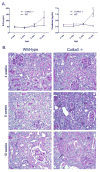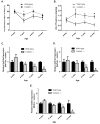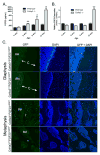Longitudinal evaluation of FGF23 changes and mineral metabolism abnormalities in a mouse model of chronic kidney disease
- PMID: 22031097
- PMCID: PMC3439562
- DOI: 10.1002/jbmr.516
Longitudinal evaluation of FGF23 changes and mineral metabolism abnormalities in a mouse model of chronic kidney disease
Abstract
Fibroblast growth factor 23 (FGF23) is a phosphaturic and vitamin D-regulatory hormone of putative bone origin that is elevated in patients with chronic kidney disease (CKD). The mechanisms responsible for elevations of FGF23 and its role in the pathogenesis of chronic kidney disease-mineral bone disorder (CKD-MBD) remain uncertain. We investigated the association between FGF23 serum levels and kidney disease progression, as well as the phenotypic features of CKD-MBD in a Col4a3 null mouse model of human autosomal-recessive Alport syndrome. These mice exhibited progressive renal failure, declining 1,25(OH)(2)D levels, increments in parathyroid hormone (PTH) and FGF23, late-onset hypocalcemia and hyperphosphatemia, high-turnover bone disease, and increased mortality. Serum levels of FGF23 increased in the earliest stages of renal damage, before elevations in blood urea nitrogen (BUN) and creatinine. FGF23 gene transcription in bone, however, did not increase until late-stage kidney disease, when serum FGF23 levels were exponentially elevated. Further evaluation of bone revealed trabecular osteocytes to be the primary cell source for FGF23 production in late-stage disease. Changes in FGF23 mirrored the rise in serum PTH and the decline in circulating 1,25(OH)(2)D. The rise in PTH and FGF23 in Col4a3 null mice coincided with an increase in the urinary fractional excretion of phosphorus and a progressive decline in sodium-phosphate cotransporter gene expression in the kidney. Our findings suggest elevations of FGF23 in CKD to be an early marker of renal injury that increases before BUN and serum creatinine. An increased production of FGF23 by bone may not be responsible for early increments in FGF23 in CKD but does appear to contribute to FGF23 levels in late-stage disease. Elevations in FGF23 and PTH coincide with an increase in urinary phosphate excretion that likely prevents the early onset of hyperphosphatemia in the face of increased bone turnover and a progressive decline in functional renal mass.
Copyright © 2012 American Society for Bone and Mineral Research.
Figures





References
-
- Moe S, Drueke T, Cunningham J, et al. Definition, evaluation, and classification of renal osteodystrophy: a position statement from Kidney Disease: Improving Global Outcomes (KDIGO) Kidney Int. 2006;69:1945–53. - PubMed
-
- Mirza MA, Larsson A, Melhus H, Lind L, Larsson TE. Serum intact FGF23 associate with left ventricular mass, hypertrophy and geometry in an elderly population. Atherosclerosis. 2009;207:546–51. - PubMed
-
- Gutierrez O, Isakova T, Rhee E, et al. Fibroblast growth factor-23 mitigates hyperphosphatemia but accentuates calcitriol deficiency in chronic kidney disease. J Am Soc Nephrol. 2005;16:2205–15. - PubMed
Publication types
MeSH terms
Substances
Grants and funding
LinkOut - more resources
Full Text Sources
Medical
Molecular Biology Databases

